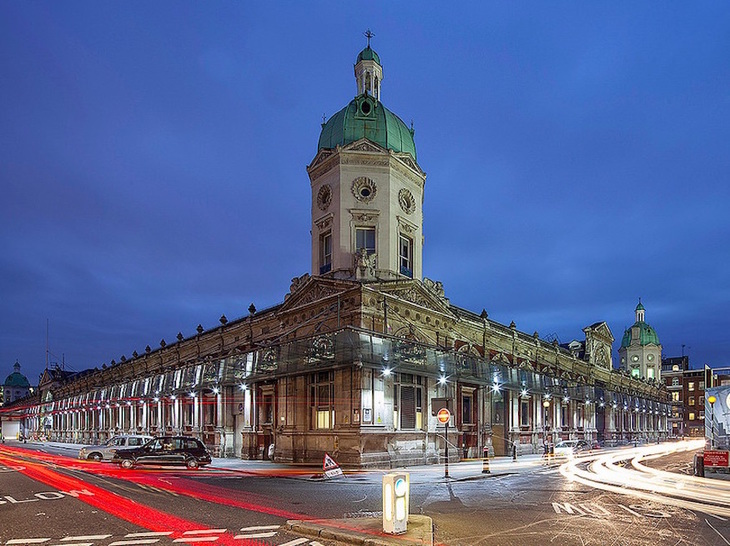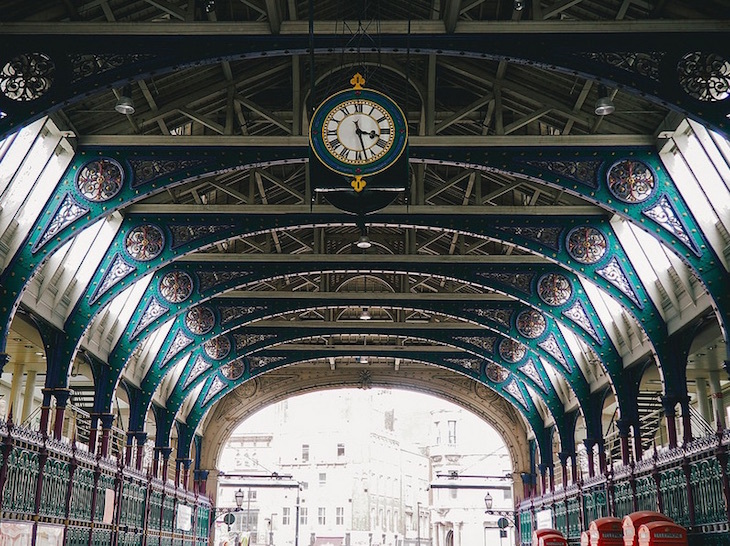
Wonder marvellously: for I will work a work in your days, which ye will not believe.
This was the Biblical boast from the Book of Habakkuk which a great mind attempted to bring to reality in great secrecy at Smithfield Meat Market in the second world war.
In 1942, ships bringing food and material were sunk in disastrous numbers in the mid-Atlantic by wolf packs of submarines. No air cover was feasible so far from land; aircraft of the time had little carrying capacity and few were capable of reaching the distance across the ocean. But when America entered the war it became possible to think more optimistically of counterattack, and even of freeing Europe from tyranny.
More Spam

The domes of Smithfield Market are the tips of an iceberg. Built by the Victorians to keep produce cool in airy colonnades, cold stores which burrowed deep underground were later added to the market. But during the war, a lot of meat arrived off-the-bone, compacted in the form of corned beef and spam to save shipping space. The cold stores, no longer needed, were left empty and ready for other uses.
We suspect that Prime Minister Winston Churchill didn't eat a lot of Spam, but he had an appetite for new ideas. He installed blue-blood Louis Mountbatten at Combined Operations HQ with staff from the Army, Navy and Air Force. Combined Operations HQ was located in Richmond Terrace, off Whitehall, adrift from the old guard at the Admiralty and the War Office, in the hope that the representatives of the different armed services would be shaken out of their traditional methods and rivalries to form new and bold plans for victory.
Geoffrey Pyke, a brilliant but sickly ‘beardy weirdy’ who might be encountered without socks and with his flies undone, was powerful medicine against tradition, and Mountbatten took him on. He was a journalist who had set up his own school, and had no military or scientific pretensions at all. But a solution to the problem of safely bridging the Atlantic formed in Pyke’s highly unusual mind.

A Dirty Snowball
The need for mid-ocean landing strips was obvious. Slightly less obvious was that one might lasso an iceberg for the purpose. But a fortuitous meeting led Pyke to a better idea. Let’s make our own berg. This far-fetched enterprise, was referred to, with varying combinations of Bs and Ks, as Project Habbakuk.
Ice floats. But, add a peck of sawdust to the water and the frozen material, henceforth known as Pykrete, becomes self-insulating and very slow to melt. All that was needed then was for engineers to work out the details and turn a dirty snowball into an aircraft carrier. Physicist J. D. Bernal worked on the project at Richmond Terrace, finding that the carrier would need to be bigger than the ill-fated Titanic - about forty times bigger. But it really would be unsinkable.

Jewish refugee and future Nobel Prize winner, Max Perutz, who was initially interned as a possible security risk, worked on Pykrete experiments at Smithfield. Of course, security was such that no one told him what it was for. But he dutifully carried out experiments five floors down in a cold store, wearing the sort of electrically heated onesie used by pilots flying at high altitude. Men in dark suits visited him, an unusual sight at the market.
The material needed to be kept in motion while it froze, like ice cream, so that the wood particles did not sink to the bottom before the start of crystallisation. It was made in a concrete mixer and the brown slush laid out on trays for final solidification in a homemade ‘wind tunnel’.
A gun fired into ice will fracture it. But Pykrete had another advantage over ice. It was shatterproof. A bullet fired in the depths of Smithfield into a block of Pykrete was stopped, and dropped out of the tiny dimple it had made. Mountbatten brought a sample to show Churchill in his bath at Chequers. After experimentation, an icy vessel of very modest proportions was successfully built on a lake in Canada.
What happened next
The berg ship idea was sunk in 1943 by improvements in aircraft range and submarine detection equipment. An aircraft carrier of rock became available in the shape of the Azores. It was eventually worked out that the refrigeration plant necessary for Habbakuk would have required as much steel as a conventional aircraft carrier.
In hindsight the ‘berg ship’ project could be dismissed as an absurdity. But the successful Normandy landings of 1944 did not come from a blank sheet. Combined Operations launched commando raids on the enemy shore when the army and navy chiefs were thinking only of defence. Eventually D-Day, a raid by 150,000 men, began the liberation of Europe. Combined Operations became a nursery for big ideas, like Habbakuk. The extraordinary Mulberry Harbours used in Normandy, depended on an inspired invention, breaking organisational barriers, and military leadership.
After the war, Pyke went on to work on another hard problem, one that proved beyond his, and our, ingenuity: running a sustainable National Health Service.
A rejuvenated Museum of London is due to open in disused market buildings at Smithfield. We like to think that there might be a subterranean pedestal reserved for a lump of icy sawdust commemorating one of the most jaw dropping projects of the second world war.



